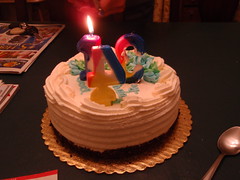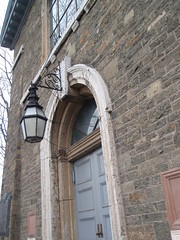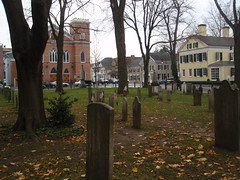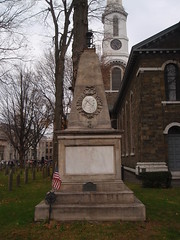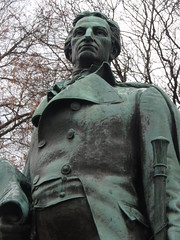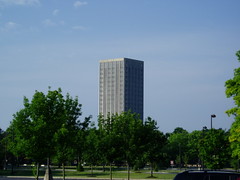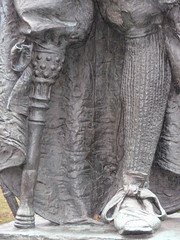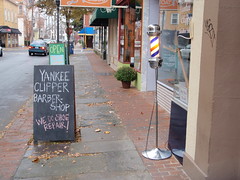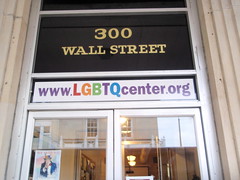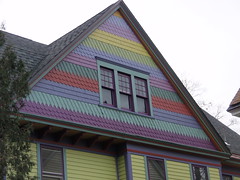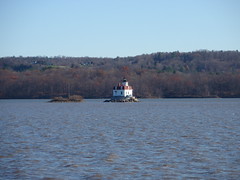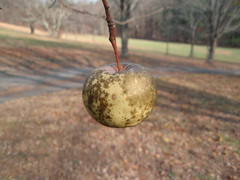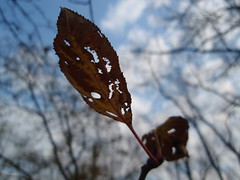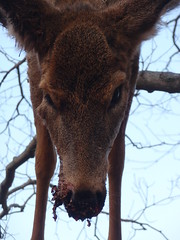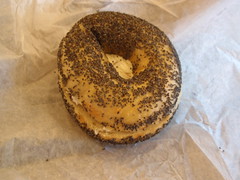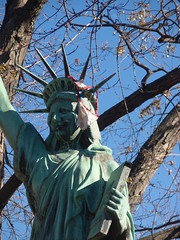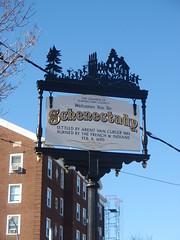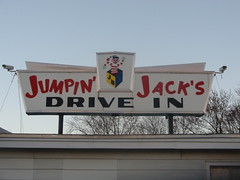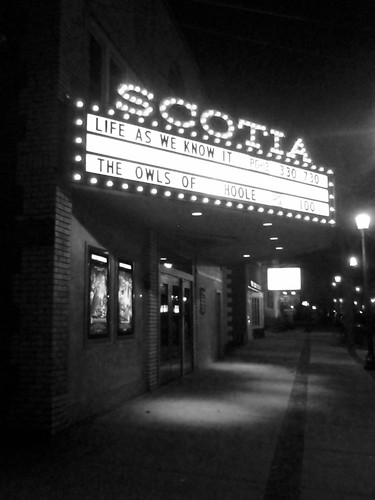After my friend Jen's wedding:
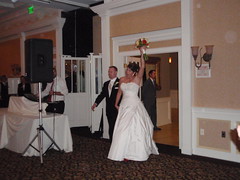
I spent a day helping unnamed drunken hungover bridesmaids stop vomiting and then took off for my parents' house, three hours further north on top of the bajillion hours I'd already spent in the car. I made pretty good time, since the Thruway is pretty much empty heading north on a Monday morning, and two-thirds of the way through the trip I decided that the rest area in Lewis County was a good place to stop. Unlike most New York rest areas, which just have a historical sign telling you that something happened there sometime, this one has actual history:
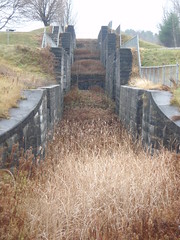
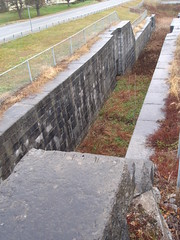
Those locks, and a few others scattered nearby, are all that's left of the
Black River Canal, which was finally abandoned less than a hundred years ago. At work we sometimes talk to our student workers about when microwave ovens first came out and just had a big dial instead of buttons, or when a Walkman cost fifty dollars, or when "The Simpsons" wasn't on the air. History and technology move pretty fast, and it's weird to drive up to the locks in my car with the power doors and power windows and computerized electronic system, listening to my iPod and taking film-less photographs of the locks with my rechargeable battery digital camera and thinking that a hundred years ago these were pretty much top of the line transportation technology.
Now they're big hunks of rock at the rest stop, a mile or so from where the river is.
I got home in time to see the last vestiges of fall:

and to see that Northern New York remains both classy and trashy:
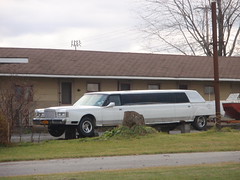
That's a stretch limo up on blocks, in front of the vacant motel near the high school. The motel lawn also contains a boat, which you can see in the picture, a bread truck, a pickup, and a tractor. They are currently missing a washing machine, some sort of varmit, and a passel o' children, but I keep hope alive each time I return home.
Home itself is largely unchanged. Philly is Philly:
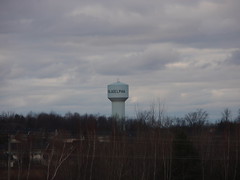
I did surprise myself by remembering how to navigate around Philly when an accident blocked Route 11 yesterday afternoon. Watching the other cars pull U-Turns and double back, I thought, "Hey, isn't there a road that connects Philly and Evans Mills? I could take that road and then pick up Route 11 again from the Mills."
"Well, yes, I'm certain there is such a road, but the better question is whether you could possibly remember where it is.""Sand Street, maybe? Do we have a Sand Street?"
"I'm not sure. We went to high school with Stacy Sands. Remember? There was that story about her and Sonja, who sat next to you in French class, and them showering together and taking pictures of it to show boys.""Yeah, I think they were cousins. They were nice. Also, I think that road is next to the water tower. It's by Deanna and Tamra's mom's house."
"Sure it is. I look forward to the blog entry about how you got lost three miles from your house and circled unmarked farm roads until you ran out of gas and had to call for help because you couldn't figure out how to walk home, either. Happy navigating, Magellan."It turns out that the road is Sandy Hollow, not Sand Street, but other than that it was exactly where I thought it was and it led exactly where I needed to go. Take that, verbally abusive inner monologue voice.
I was on the road because I wanted to head into Watertown after I'd spent an interesting hour at the Philadelphia Historical Society Museum:
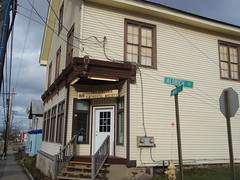
Last time I was home we didn't have a museum, and that building housed an antique shop. Now it's a museum, and it's currently exhibiting over 40 quilts that my friend Bill's mom made. Given that the museum is only three rooms, this means that there are quilts everywhere:
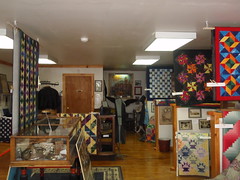
but they are all labeled and they give you a handout when you come in so that you can follow the numbers and read about each one. The people working at the museum are also happy to walk through it with you and tell you about everything there, which was actually very informative. Remember when I went to
Bizarro Philly and remarked that actual Philly hasn't contributed anything to the historical record?
That's because everything that ever was in Philly burned down.
Every time I stopped at a case to look at photographs, the story was the same: "That's the original town hall building. The Big M building is on the same footprint. The town hall burned down, and the hot bricks fell through the roof of the restaurant next door and burned that down, too."
"That hotel used to stand by the railroad depot, where the Countie Supply is now.

Took three men with it when it burned."
"Oh, that eagle came from the Eagle Hotel. We had two hotels, then. They got it and the painting there out just before the hotel burned."
"This building used to be the post office. That burned up just recently."
"Yes, we were living here then. My mom called me while it was burning down."
"Just recently", as used there, I think means "about ten years ago".
Sensing an untapped well of local history, I asked the question about Philly that has always nagged at me:
"Why is there a cemetary in the outfield over at the school?"
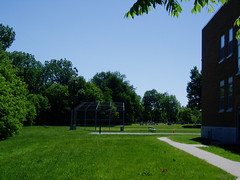
"Well, that's not the original school building. It's close to where the original was, you see, if you look at this photo, but the original-"
"Burned?"
"Yes! How'd you know?"
"Lucky guess."
After I'd signed the guestbook and experienced enough of the Burning of Philly, one building at a time, I headed to Watertown via Sandy Hollow Road because I'd heard that the Flower Memorial Library was a beautiful showpiece, and somehow I've never been inside. It turns out that the rumors were true. The building is imposing and stately enough from the outside:
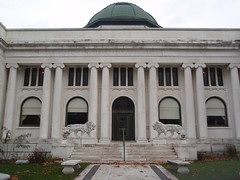
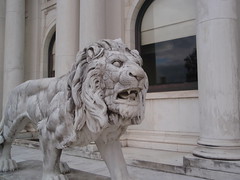
and inside, at least in the original parts, it is gorgeous:
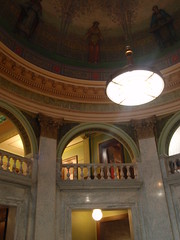
The rotunda dome is covered in a mural celebrating greath writers:
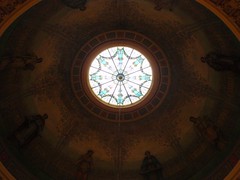
and the marble floor beneath is inset with the symbols of the Zodiac:

There are high ceilinged reading rooms:
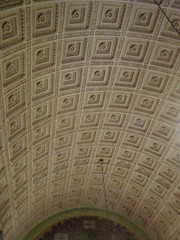

and, for some unknown reason, a room that's a tribute to Napolean:

When you head upstairs:
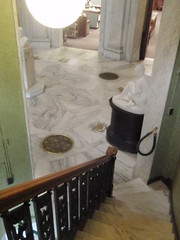
there are some historical paintings:

and a few more reading rooms radiating out from the gallery:
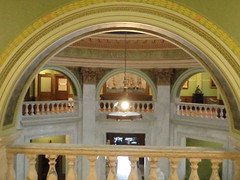
The modern library is built onto the back of the original, so everything is mostly intact, and it's really nice to walk through even if the lady at the circulation desk hisses, "Please no flash photography!" the minute you take out your camera. I'm thinking that they need a sign.
After the library I had some time to kill before I met my mom for dinner, so I did what most Americans do when they have time to kill and nowhere specific to be: I went to the mall. Other than killing time I had an actual purpose in being there, though. I wanted to see if this machine still existed:
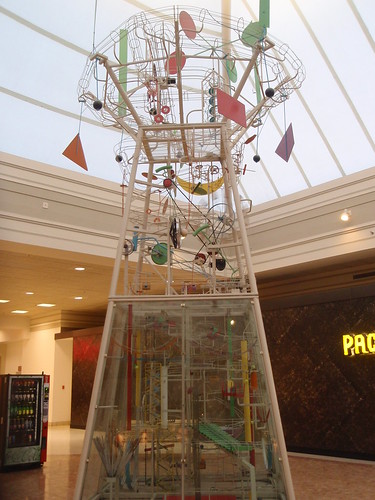
That sculpture is the "Perpetuball Motion Machine #1", and that used to be the centerpiece of the mall. Little kids would stare at it for hours as the pool balls lifted from the bottom:

and then dropped down through the machine's many loops and chutes:
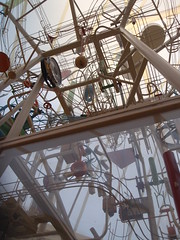
Like the mall, I guess the machine has seen better days. It has been moved off to a side aisle, and the number of balls sitting in the bottom, off track, suggests that it is slowly breaking down:

Entropy triumphs over everything, even the mall.
Or, in Philly, entropy in the form of fire.


